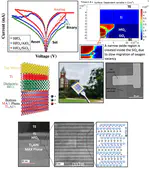layered material
(i) Addition of barrier layer in HfOx devices - Oxygen ion dynamics influence resistance changes. Integrating a SiOx (< 1 nm) barrier layer near the reset anode interface can control this, leading to gradual resistance changes during positive analog pulses. While the HfOx/SiOx devices outperform standard ones, there’s a trade-off between linearity and switching window because of a small oxide formation in the filament. The barrier layer devices, despite better linearity, have high reset current densities, necessitating further low-power synapse investigation. [ACS Applied Electronic Materials]
(ii) Off-current reduction using ultrathin multi-layered low thermally conductive materials - I posited that electrodes with low thermal conductivity could localize heat in the filament, thereby enlarging the rupture oxide area and decreasing current density. While most such materials are unsuitable as electrodes, the MAX phase uniquely combines low thermal conductivity with high electrical conductivity. Because of the ultrathin multi-layered structure, the MAX phase can confine heat and act as a better oxygen reservoir for the memristor. I fabricated memristors with MAX phase electrodes, verifying the fabrication via methods such as Raman Spectroscopy, Transmission electron microscopy, and in-situ XRD. These devices displayed ultra-low reset current density, high on-off ratio, and superior endurance, emphasizing the promise of MAX phase materials in energy-efficient, high-density memory systems. [Advanced Functional Materials]
(ii) Off-current reduction using ultrathin multi-layered low thermally conductive materials - I posited that electrodes with low thermal conductivity could localize heat in the filament, thereby enlarging the rupture oxide area and decreasing current density. While most such materials are unsuitable as electrodes, the MAX phase uniquely combines low thermal conductivity with high electrical conductivity. Because of the ultrathin multi-layered structure, the MAX phase can confine heat and act as a better oxygen reservoir for the memristor. I fabricated memristors with MAX phase electrodes, verifying the fabrication via methods such as Raman Spectroscopy, Transmission electron microscopy, and in-situ XRD. These devices displayed ultra-low reset current density, high on-off ratio, and superior endurance, emphasizing the promise of MAX phase materials in energy-efficient, high-density memory systems. [Advanced Functional Materials]
